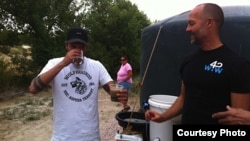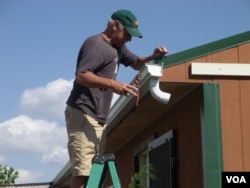PINE RIDGE RESERVATION, South Dakota — Brown and yellow hills and fields stretch out around the Pine Ridge Reservation for miles in all directions. They’re not green because, like much of the rest of the country, South Dakota is in the middle of a drought year. Many municipalities are considering or have already begun water restrictions.
But one Lakota family is taking a step back into the past to find a new way to access water.
On a beautiful Sunday afternoon on the White Plume ranch, several young Lakota men and women are hard at work helping to attach gutters to the roof.
Heading up the effort is Jon Rose, founder of Waves for Water. “It’s a non-profit organization that provides access to clean drinking water for places around the world that need it. We have active programs in 13 countries...Indonesia, Brazil, Afghanistan, Pakistan, Nicaragua, India.”
The list goes on. The former professional surfer traveled the world for 13 years and saw the need for clean water in many countries. He established Waves for Water in 2009.
His company is at the White Plume residence to install a rain catchment system that will allow the family to collect clean drinking water. Many of the wells on the Pine Ridge reservation have been contaminated by years of uranium mining in the area.
"We do filters in a lot of places around the world," says Rose. "But the filters we use are for biological contaminants. They’re not going to take out uranium. But we also do rain catchment systems in Africa, for schools in Africa. My dad’s the mastermind with the rain catchment stuff. So, I looked at Deb and Alex [White Plume] and said…your groundwater’s screwed. Let’s just bypass it and let’s catch rainwater.”
Jack Rose, the rain catchment mastermind and Jon's father, says the system is simple to install, maintain and operate. All that’s required is a roof, rain gutters, a holding tank and pipes - leading from the gutters through a filter to the storage tank.
“We can take any building and make it into a rain catcher, simply by putting rain gutters on it,” Jack says. “I tell people that catching rain is the easiest thing a human can do. I mean, it’s really…if you and I were stranded on an island, we’d get banana leaves and channel rain into something to store it in. People may think it’s hard to do, but it really is simple. Like here, it’s a weekend project.”
Jack adds that it’s not just about providing clean water for circumstances like the White Plumes’; it’s also about bringing water into areas that are suffering from drought. Even in the current dry spell, he says, over time there will be enough rain to supply a home with drinking water.
“Every week in the headlines, it says ‘Rural water shortage, rural water shortage.’ I actually say there isn’t a shortage of water given, there’s a shortage of water received,” he says.
Received, in this case, via rain catchment.
Considering that it takes just 2.5 centimeters of rain to provide almost 2,000 liters of clean water into her new holding tank, ranch owner Deb White Plume says that system should be the norm, not the exception.
“I think water is being handled in a really disrespectful manner. I think water is being wasted. It’s being contaminated. And, in America, I think it should be criminal that one-fourth of the drinking water coming into our homes leaves when we flush our toilets.”
As her granddaughter, Brooklyn, uses well water to wash the dinner dishes, Plume says clean drinking water - whatever its source - is a resource that no one can afford to squander.
But one Lakota family is taking a step back into the past to find a new way to access water.
On a beautiful Sunday afternoon on the White Plume ranch, several young Lakota men and women are hard at work helping to attach gutters to the roof.
Heading up the effort is Jon Rose, founder of Waves for Water. “It’s a non-profit organization that provides access to clean drinking water for places around the world that need it. We have active programs in 13 countries...Indonesia, Brazil, Afghanistan, Pakistan, Nicaragua, India.”
The list goes on. The former professional surfer traveled the world for 13 years and saw the need for clean water in many countries. He established Waves for Water in 2009.
His company is at the White Plume residence to install a rain catchment system that will allow the family to collect clean drinking water. Many of the wells on the Pine Ridge reservation have been contaminated by years of uranium mining in the area.
"We do filters in a lot of places around the world," says Rose. "But the filters we use are for biological contaminants. They’re not going to take out uranium. But we also do rain catchment systems in Africa, for schools in Africa. My dad’s the mastermind with the rain catchment stuff. So, I looked at Deb and Alex [White Plume] and said…your groundwater’s screwed. Let’s just bypass it and let’s catch rainwater.”
Jack Rose, the rain catchment mastermind and Jon's father, says the system is simple to install, maintain and operate. All that’s required is a roof, rain gutters, a holding tank and pipes - leading from the gutters through a filter to the storage tank.
“We can take any building and make it into a rain catcher, simply by putting rain gutters on it,” Jack says. “I tell people that catching rain is the easiest thing a human can do. I mean, it’s really…if you and I were stranded on an island, we’d get banana leaves and channel rain into something to store it in. People may think it’s hard to do, but it really is simple. Like here, it’s a weekend project.”
Jack adds that it’s not just about providing clean water for circumstances like the White Plumes’; it’s also about bringing water into areas that are suffering from drought. Even in the current dry spell, he says, over time there will be enough rain to supply a home with drinking water.
“Every week in the headlines, it says ‘Rural water shortage, rural water shortage.’ I actually say there isn’t a shortage of water given, there’s a shortage of water received,” he says.
Received, in this case, via rain catchment.
Considering that it takes just 2.5 centimeters of rain to provide almost 2,000 liters of clean water into her new holding tank, ranch owner Deb White Plume says that system should be the norm, not the exception.
“I think water is being handled in a really disrespectful manner. I think water is being wasted. It’s being contaminated. And, in America, I think it should be criminal that one-fourth of the drinking water coming into our homes leaves when we flush our toilets.”
As her granddaughter, Brooklyn, uses well water to wash the dinner dishes, Plume says clean drinking water - whatever its source - is a resource that no one can afford to squander.


